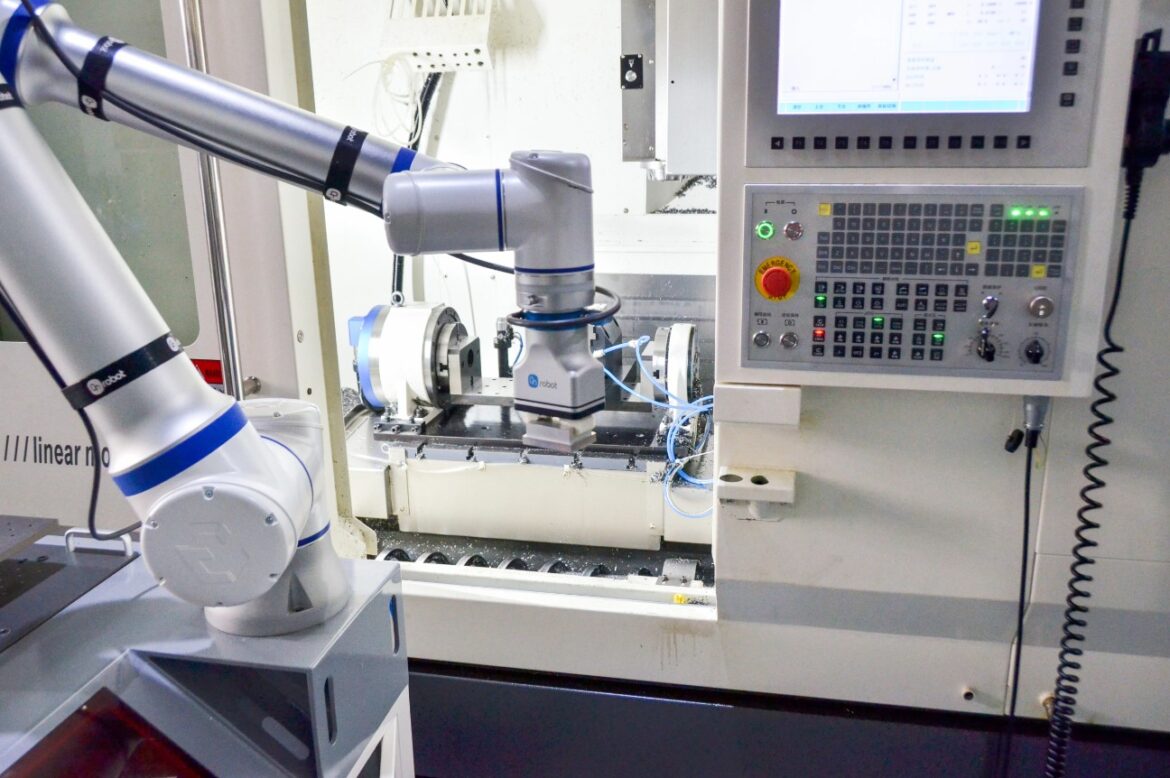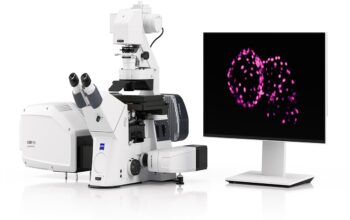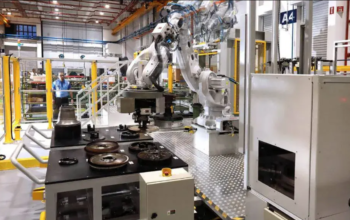As we navigate through the rapid advancements in technology, one of the most exciting developments in manufacturing is the rise of collaborative robots, or cobots.
Unlike traditional industrial robots that are often isolated behind cages for safety, cobots are designed to work directly alongside human workers, enhancing both efficiency and productivity in the manufacturing process.
The integration of cobots in modern manufacturing is revolutionizing how we approach production, bringing a new era of collaboration between man and machine.
In this article, we’ll dive into the key benefits of incorporating cobots into manufacturing, showing how they are not just a trend but a significant leap forward in the industry.
Let’s get right into it!
Increased Efficiency and Productivity
One of the primary advantages of using cobots in modern manufacturing is the significant boost in efficiency and productivity they bring to the table.
Cobots are engineered to work in tandem with human operators, handling repetitive or strenuous tasks that would otherwise slow down the production line.
This collaboration allows human workers to focus on more complex and creative aspects of manufacturing, leading to a more dynamic and productive workflow.
Furthermore, the integration of cobots allows for continuous production without the fatigue factor that typically affects human workers.
Cobots can work tirelessly around the clock, maintaining a steady pace without compromising on precision. This capability leads to an overall increase in throughput, making the investment in cobots highly beneficial for manufacturers looking to stay ahead of the curve. For a deeper understanding of their role in modern manufacturing, you can explore our other blog post, “What is a Cobot,” to learn more about how these collaborative robots are transforming the industry.
Improved Safety in the Workplace
Another significant benefit of deploying cobots in modern manufacturing is the enhanced safety they provide in the workplace. Traditional industrial robots require strict safety measures, including barriers and sensors, to prevent accidental contact with human workers.
Cobots, on the other hand, are designed with built-in safety features that allow them to operate safely alongside people without the need for extensive protective measures.
Cobots are equipped with sensors and advanced algorithms that enable them to detect and respond to the presence of humans. If a human worker comes too close, the cobot can slow down or stop altogether to avoid any potential accidents.
This makes the manufacturing environment much safer, particularly in industries where hazardous materials or heavy machinery are involved. The reduction in workplace accidents not only protects workers but also reduces downtime and associated costs, further enhancing the overall efficiency of the production process.
By incorporating cobots into the manufacturing workflow, we’re not just improving productivity; we’re also creating a safer and more sustainable work environment.
The cobot in modern manufacturing is a testament to how technology can harmonize with human effort to achieve safer, more efficient production.
Flexibility and Adaptability
In today’s fast-paced manufacturing landscape, flexibility is key. The ability to adapt quickly to changes in demand, product design, or production methods can be the difference between staying competitive or falling behind.
This is where cobots truly shine. Unlike traditional industrial robots that are often rigid and require extensive reprogramming for new tasks, cobots offer a level of flexibility that makes them invaluable in modern manufacturing. The CS66 robotic arm is a prime example, ideal for simplifying a wide variety of processing tasks to the extreme. Its ability to support a large number of End-of-Arm Tools (EoATs) and other equipment, combined with unmatched ease of use, makes this cobot the must-have choice for seamlessly automating tasks such as machine tending, quality inspection, screw-driving, and more.
Cobots are designed to be easily programmable and can be redeployed to different tasks with minimal downtime. This adaptability means that manufacturers can quickly switch between different production lines or product types without the need for significant retooling.
For instance, in a factory that produces consumer electronics, a cobot might be used for assembling circuit boards one day and packaging products the next. This kind of versatility allows manufacturers to respond swiftly to changes in consumer demand or market conditions.
Moreover, cobots can be integrated into existing workflows without major disruptions. Their compact size and collaborative nature mean they can work alongside human operators on the factory floor without requiring extensive modifications to the layout or infrastructure. Small in size but great in applications, the CS63 cobot exemplifies this flexibility by meticulously performing lightweight tasks. It’s optimal for table-top and soft-grip applications, making it ideal for research and education settings. The CS63 robotic arm truly is your little big automation partner, bringing both accuracy and versatility to your production line.
This ease of integration further enhances their value in a manufacturing environment that increasingly demands agility and responsiveness.
The flexibility of the cobot in modern manufacturing also extends to its ability to learn and improve over time. With advancements in machine learning and artificial intelligence, cobots can be programmed to optimize their performance based on real-time data.
This means that as they perform tasks, they become more efficient and accurate, continuously improving the quality of the output.
Cost-Effectiveness
When it comes to adopting new technology, cost is always a critical consideration. Fortunately, cobots offer a cost-effective solution for manufacturers looking to enhance their operations without breaking the bank.
The initial investment in cobots is typically lower than that for traditional industrial robots, primarily due to their smaller size, simpler installation requirements, and the absence of the need for extensive safety measures like cages and barriers. The EC66 cobots, with their lightweight design, offer effortless multi-angle installation, making them highly versatile for various applications. With the ability to reach over 250 mm further than an average human arm, these robotic arms are ideal for tasks that require placing items within machines or completing tasks outside the reach of employees.
Beyond the upfront savings, cobots also offer significant long-term cost benefits. Their ability to work alongside human workers reduces the need for extensive automation systems, allowing manufacturers to maintain a leaner, more efficient operation.
Additionally, because cobots are designed to be easily reprogrammable and adaptable, cobots can be used for multiple tasks over their lifespan, providing a better return on investment compared to single-purpose machines.
Another aspect of cost-effectiveness is the reduction in labor costs associated with repetitive or hazardous tasks.
By automating these tasks with cobots, manufacturers can minimize the risk of workplace injuries and associated compensation claims, while also freeing up human workers to focus on more valuable, higher-skilled activities. This shift not only reduces costs but also leads to a more engaged and motivated workforce.
In summary, the cost-effectiveness of integrating a cobot in modern manufacturing extends beyond just the initial purchase price. It encompasses ongoing savings in labor, maintenance, and operational efficiency, making cobots a smart investment for companies of all sizes.
Enhanced Precision and Quality
Precision is paramount in manufacturing, and cobots are instrumental in achieving the high levels of accuracy required in today’s production processes. These collaborative robots excel at performing tasks with meticulous precision, ensuring consistent quality across all products.
This is especially crucial in industries like electronics, automotive, and medical devices, where even the slightest deviation can lead to significant issues.
Cobots are equipped with advanced sensors and control systems that allow them to perform tasks with a level of accuracy that surpasses human capabilities. Whether it’s assembling delicate components or applying the exact amount of adhesive, cobots ensure that every action is performed with pinpoint precision. This not only reduces the margin of error but also minimizes waste, leading to more efficient use of materials and resources. Featuring both a long reach and a high payload, the CS612 cobot strikes the perfect balance between flexibility and power, opening the door to an infinite range of applications—from machine tending to mobility solutions with AGVs.
A great example of this precision is seen in the automotive industry, where cobots are used to apply sealants to car windshields. The consistency and accuracy with which cobots perform this task result in a flawless seal every time, reducing the likelihood of defects and improving the overall quality of the final product.
By integrating cobots into these critical stages of production, manufacturers can achieve higher standards of quality, ensuring that their products meet or exceed customer expectations.
Moreover, the use of cobots in quality control processes further enhances product quality. Cobots can be programmed to inspect products at various stages of production, identifying defects or inconsistencies that might be missed by human inspectors.
This ensures that only products that meet stringent quality standards make it to the market, protecting the brand’s reputation and reducing the cost of returns or recalls.
Collaboration with Human Workers
One of the most significant advantages of cobots is their ability to work collaboratively with human workers. Unlike traditional robots, which are often isolated from humans due to safety concerns, cobots are specifically designed to operate safely alongside people.
This collaborative nature opens up new possibilities for optimizing production processes by combining the strengths of both human workers and machines.
Cobots can handle repetitive, physically demanding, or hazardous tasks, allowing human workers to focus on more strategic, creative, or problem-solving activities.
This division of labor not only improves efficiency but also enhances job satisfaction, as workers are relieved from monotonous tasks and can contribute in more meaningful ways.
Furthermore, the interaction between cobots and human workers is seamless, thanks to intuitive programming interfaces and user-friendly controls. For those requiring the highest level of performance, Elite Robots‘ top-end model, the CS620 robotic arm, takes automation to the next level. Equipped with a dual 3A/5A tool connector for enhanced power, the CS620 features a remarkable 20 kg payload and the longest reach of all CS cobots. This model is designed to handle more demanding tasks while maintaining effortless integration with existing workflows and user-friendly operation.
Workers can easily program and adjust cobots without needing specialized technical skills, making it easier to integrate cobots into the workflow. This ease of use ensures that cobots can be quickly adapted to different tasks as needed, enhancing the overall flexibility and productivity of the workforce.
The collaboration between humans and cobots represents a new era in manufacturing, where technology enhances rather than replaces human capabilities. The cobot in modern manufacturing is not just a tool but a partner that helps us achieve greater efficiency, precision, and quality in our work.
The Future of Manufacturing with Cobots
The integration of cobots in modern manufacturing is transforming the industry by enhancing efficiency, safety, flexibility, cost-effectiveness, precision, and collaboration. At Elite Robots, we are at the forefront of this revolution, offering cutting-edge cobot solutions that redefine the possibilities of automation.









